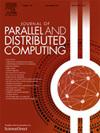通过可建模的任务调度利用多实例gpu
IF 3.4
3区 计算机科学
Q1 COMPUTER SCIENCE, THEORY & METHODS
引用次数: 0
摘要
NVIDIA MIG (Multi-Instance GPU)允许将一个物理GPU划分为多个逻辑实例,这些实例具有完全隔离的资源,可以动态重新配置。这项工作通过动态重新配置的可建模任务调度突出了MIG尚未开发的潜力。具体来说,我们提出了在MIG约束下多任务执行的最大完成时间最小化问题。我们的分析表明,假设任务工作相对于资源是单调的,这在多核调度中是不可行的。依靠最先进的建议,不需要这样的假设,我们提出FAR,一个三阶段算法来解决这个问题。FAR的第一阶段建立在经典的任务可塑性方法之上,第二阶段结合了最长处理时间优先和列表调度以及针对MIG约束的新颖的重新划分树启发式方法,第三阶段通过任务移动和交换使用本地搜索。FAR脱机分批调度任务,以一种有利于资源重用的改进方式动态地连接它们的调度。排除重新配置成本,列表调度证明显示NVIDIA A30模型上的近似因子为7/4。我们将该技术应用于NVIDIA A100/H100的特定约束,以获得近似因子2。包括重新配置成本在内,我们的真实世界实验表明,对于一组著名的基准测试,相对于最优的makespan不低于1.22倍,对于由真实内核启发的合成输入,makespan不低于1.10倍。我们对每批任务都获得了良好的实验结果,而且在批的串联中也获得了良好的实验结果,比最新的技术和建议有了很大的改进,而不需要重新配置GPU。此外,我们表明,提出的启发式允许正确的适应任务非常不同的特点。除了具体的算法之外,本文还展示了MIG技术的研究潜力,并为该领域的未来工作提出了有用的度量、工作量表征和评估技术。本文章由计算机程序翻译,如有差异,请以英文原文为准。
Leveraging Multi-Instance GPUs through moldable task scheduling
NVIDIA MIG (Multi-Instance GPU) allows partitioning a physical GPU into multiple logical instances with fully-isolated resources, which can be dynamically reconfigured. This work highlights the untapped potential of MIG through moldable task scheduling with dynamic reconfigurations. Specifically, we propose a makespan minimization problem for multi-task execution under MIG constraints. Our profiling shows that assuming monotonicity in task work with respect to resources is not viable, as is usual in multicore scheduling. Relying on a state-of-the-art proposal that does not require such an assumption, we present FAR, a 3-phase algorithm to solve the problem. Phase 1 of FAR builds on a classical task moldability method, phase 2 combines Longest Processing Time First and List Scheduling with a novel repartitioning tree heuristic tailored to MIG constraints, and phase 3 employs local search via task moves and swaps. FAR schedules tasks in batches offline, concatenating their schedules on the fly in an improved way that favors resource reuse. Excluding reconfiguration costs, the List Scheduling proof shows an approximation factor of 7/4 on the NVIDIA A30 model. We adapt the technique to the particular constraints of an NVIDIA A100/H100 to obtain an approximation factor of 2. Including the reconfiguration cost, our real-world experiments reveal a makespan with respect to the optimum no worse than 1.22× for a well-known suite of benchmarks, and 1.10× for synthetic inputs inspired by real kernels. We obtain good experimental results for each batch of tasks, but also in the concatenation of batches, with large improvements over the state-of-the-art and proposals without GPU reconfiguration. Moreover, we show that the proposed heuristics allow a correct adaptation to tasks of very different characteristics. Beyond the specific algorithm, the paper demonstrates the research potential of the MIG technology and suggests useful metrics, workload characterizations and evaluation techniques for future work in this field.
求助全文
通过发布文献求助,成功后即可免费获取论文全文。
去求助
来源期刊

Journal of Parallel and Distributed Computing
工程技术-计算机:理论方法
CiteScore
10.30
自引率
2.60%
发文量
172
审稿时长
12 months
期刊介绍:
This international journal is directed to researchers, engineers, educators, managers, programmers, and users of computers who have particular interests in parallel processing and/or distributed computing.
The Journal of Parallel and Distributed Computing publishes original research papers and timely review articles on the theory, design, evaluation, and use of parallel and/or distributed computing systems. The journal also features special issues on these topics; again covering the full range from the design to the use of our targeted systems.
 求助内容:
求助内容: 应助结果提醒方式:
应助结果提醒方式:


